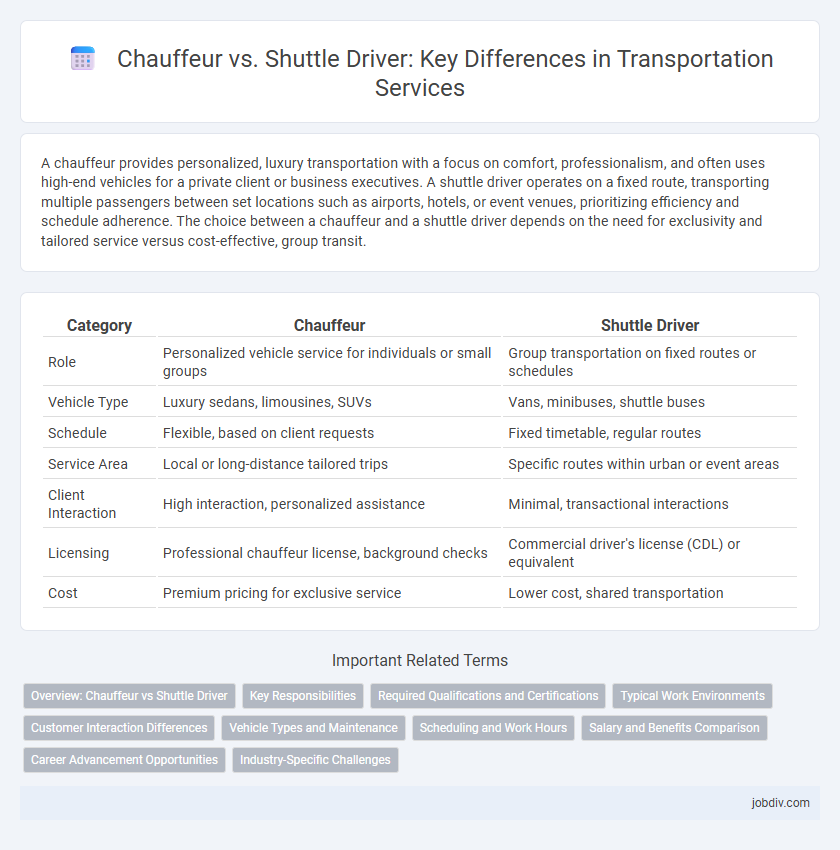A chauffeur provides personalized, luxury transportation with a focus on comfort, professionalism, and often uses high-end vehicles for a private client or business executives. A shuttle driver operates on a fixed route, transporting multiple passengers between set locations such as airports, hotels, or event venues, prioritizing efficiency and schedule adherence. The choice between a chauffeur and a shuttle driver depends on the need for exclusivity and tailored service versus cost-effective, group transit.
Table of Comparison
| Category | Chauffeur | Shuttle Driver |
|---|---|---|
| Role | Personalized vehicle service for individuals or small groups | Group transportation on fixed routes or schedules |
| Vehicle Type | Luxury sedans, limousines, SUVs | Vans, minibuses, shuttle buses |
| Schedule | Flexible, based on client requests | Fixed timetable, regular routes |
| Service Area | Local or long-distance tailored trips | Specific routes within urban or event areas |
| Client Interaction | High interaction, personalized assistance | Minimal, transactional interactions |
| Licensing | Professional chauffeur license, background checks | Commercial driver's license (CDL) or equivalent |
| Cost | Premium pricing for exclusive service | Lower cost, shared transportation |
Overview: Chauffeur vs Shuttle Driver
Chauffeurs provide personalized, luxury transportation services often catering to individual clients or executives, emphasizing comfort, discretion, and tailored routes. Shuttle drivers operate on fixed schedules or routes, typically transporting multiple passengers between predetermined locations such as airports, hotels, or corporate campuses. Both roles require professional driving skills but differ significantly in service style, vehicle type, and customer interaction.
Key Responsibilities
Chauffeurs are responsible for providing personalized, luxury transportation services, ensuring passenger comfort, safety, and discretion while managing routes and vehicle maintenance for high-profile clients. Shuttle drivers operate on fixed routes and schedules, transporting multiple passengers efficiently between specific locations such as airports, hotels, or corporate campuses. Both roles require strong navigation skills and adherence to traffic laws, but chauffeurs emphasize tailored services while shuttle drivers prioritize timely group transport.
Required Qualifications and Certifications
Chauffeurs typically require a professional driver's license, extensive knowledge of local routes, and often additional certifications such as a chauffeur's permit or commercial driver's license (CDL) depending on the region. Shuttle drivers generally need a valid driver's license and may require a Passenger Carrying Vehicle (PCV) license or similar certification to comply with safety regulations and passenger transport laws. Both roles demand a clean driving record, customer service skills, and sometimes specialized training on vehicle operation and passenger safety standards.
Typical Work Environments
Chauffeurs typically work in private, luxury settings such as corporate offices, upscale hotels, or exclusive events where personalized, high-end service is required. Shuttle drivers operate primarily in commercial or public venues like airports, hotels, theme parks, or corporate campuses, managing scheduled group transportation along set routes. The work environment for chauffeurs emphasizes discretion and comfort, while shuttle drivers focus on efficiency and handling multiple passengers efficiently.
Customer Interaction Differences
Chauffeurs provide personalized, high-end customer service with tailored attention, often building relationships through direct communication and addressing specific client preferences. Shuttle drivers interact with multiple passengers, focusing on efficient, timely service and general assistance rather than personalized engagement. The chauffeur's role emphasizes luxury and exclusivity, while shuttle drivers prioritize group transport and operational logistics.
Vehicle Types and Maintenance
Chauffeurs typically operate luxury sedans or high-end vehicles such as Mercedes-Benz S-Class or Cadillac Escalades, requiring meticulous maintenance schedules to ensure premium comfort and reliability for individual clients. Shuttle drivers usually manage larger vehicles like passenger vans or minibusses, emphasizing routine safety inspections and group capacity maintenance to accommodate multiple passengers efficiently. Vehicle upkeep for chauffeurs involves specialized detailing and mechanical checks focused on aesthetics and smooth performance, while shuttle vehicle maintenance prioritizes durability and compliance with safety regulations.
Scheduling and Work Hours
Chauffeurs typically operate on personalized schedules tailored to individual clients, often requiring flexible hours that extend beyond standard working times, including weekends and late nights. Shuttle drivers follow fixed routes and set shifts, providing consistent, predictable work hours aligned with public transportation or corporate timetables. The variance in scheduling reflects the distinct nature of chauffeur services, emphasizing exclusivity, versus shuttle driving, which prioritizes routine and group transport efficiency.
Salary and Benefits Comparison
Chauffeurs typically earn higher salaries, with averages ranging from $50,000 to $75,000 annually, compared to shuttle drivers who usually make between $30,000 and $45,000 per year. Chauffeurs often receive premium benefits including comprehensive health insurance, retirement plans, and tips, whereas shuttle drivers may have limited benefits focused on basic healthcare and minimal bonuses. The salary and benefits gap is influenced by factors such as professional driving experience, client exclusivity, and vehicle maintenance responsibilities.
Career Advancement Opportunities
Chauffeurs often have greater career advancement opportunities due to specialized skills in luxury vehicle operation, personalized client service, and high-profile networking. Shuttle drivers typically face more limited progression, primarily within fleet management or broader transportation logistics roles. Developing expertise in customer relations and vehicle maintenance can enhance growth prospects for both professions.
Industry-Specific Challenges
Chauffeurs face industry-specific challenges such as maintaining personalized, high-end customer service while navigating complex urban traffic and adhering to strict privacy protocols. Shuttle drivers encounter operational difficulties including managing fixed routes, ensuring punctuality during peak hours, and accommodating diverse passenger needs in high-traffic environments. Both roles demand strong safety compliance, real-time problem-solving skills, and adaptability to evolving transportation regulations.
Chauffeur vs Shuttle Driver Infographic

 jobdiv.com
jobdiv.com